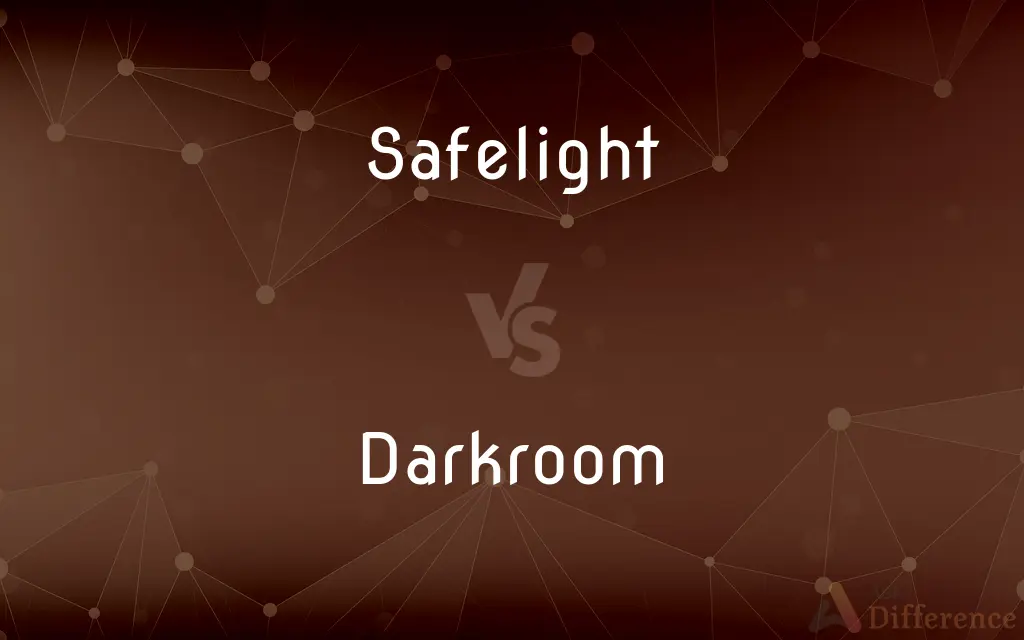Safelight vs. Darkroom — What's the Difference?
Edited by Tayyaba Rehman — By Urooj Arif — Updated on May 6, 2024
Safelights are used in darkrooms to provide light without affecting light-sensitive materials, while darkrooms are controlled environments designed for photographic processing.

Difference Between Safelight and Darkroom
Table of Contents
ADVERTISEMENT
Key Differences
Safelights enable photographers to see while working with light-sensitive photographic materials, emitting light that does not expose photo paper or films. On the other hand, darkrooms are specially designed rooms that are made light-tight to prevent any unwanted exposure of photographic materials during processing.
The design of a safelight involves specific filters that control the wavelength and intensity of light, ensuring that it is safe for use around certain types of photographic emulsions. Whereas, a darkroom requires meticulous setup to completely block out all external light, utilizing blackout materials on doors and windows.
Safelights are often used during the development stage of photographic printing or film processing where minimal light is necessary. Conversely, darkrooms are essential throughout the entire process of film development, from loading the film onto reels to the final print washing.
While safelights are usually equipped with red or amber lights to minimize photochemical reactions, the overall environment of a darkroom must remain adaptable to various stages of film and print processing, requiring different levels of light control and ventilation.
In terms of utility, safelights provide just enough illumination to manage tasks without compromising the light sensitivity of materials. Darkrooms, on the other hand, serve as a comprehensive workspace for photographers to manipulate and develop film and prints in complete darkness when needed.
ADVERTISEMENT
Comparison Chart
Purpose
Provides safe lighting
Ensures a light-controlled environment
Usage
During specific development stages
Throughout the entire process
Light Type
Red or amber
No light when in complete use
Installation Location
Inside a darkroom
Specially designed room
Impact on Materials
Minimal to no exposure risk
Prevents all exposure risks
Compare with Definitions
Safelight
A specific type of lighting designed to emit light at wavelengths that do not expose photosensitive materials.
He checked the safelight's filter to ensure it was appropriate for the type of photographic paper he was using.
Darkroom
A room designed to process photographic materials, free from unwanted light.
He entered the darkroom, ensuring the door was sealed to prevent light leaks.
Safelight
A light used in photographic darkrooms that does not affect light-sensitive materials.
The safelight was turned on to allow visibility without damaging the undeveloped film.
Darkroom
Utilized for film development and photographic printing.
They spent hours in the darkroom developing the day's photos.
Safelight
Essential for maintaining visibility in darkroom settings without compromising photo processing.
Without the safelight, it would be impossible to perform precise adjustments on the enlarger.
Darkroom
Must be equipped with light-sealing solutions to prevent exposure.
The darkroom's curtains were specially coated to block out any external light.
Safelight
Used during film loading, developing, and printing stages.
She adjusted the safelight so she could better see the film she was developing.
Darkroom
Often equipped with enlargers and other photographic equipment.
The darkroom featured several enlargers for different formats of film.
Safelight
Commonly red or amber to minimize photochemical reactions.
The darkroom was equipped with a red safelight to protect the film during handling.
Darkroom
Requires strict control of environmental conditions like temperature and humidity.
The humidity in the darkroom was controlled to prevent the photographic paper from warping.
Safelight
A safelight is a light source suitable for use in a photographic darkroom. It provides illumination only from parts of the visible spectrum to which the photographic material in use is nearly, or completely insensitive.
Darkroom
A darkroom is used to process photographic film, to make prints and to carry out other associated tasks. It is a room that can be made completely dark to allow the processing of the light-sensitive photographic materials, including film and photographic paper.
Safelight
A lamp having one or more color filters allowing moderate darkroom illumination without affecting photosensitive film or paper.
Darkroom
A room in which photographic materials are processed, either in complete darkness or with a safelight.
Safelight
The lamp in a photographic darkroom.
Darkroom
(photography) A dark room, where photographs are developed.
Darkroom
A room in which photographs are developed
Common Curiosities
What are common features of a darkroom?
Common features include light-tight seals, controlled ventilation, and equipment like enlargers and wash stations.
How do you test if a safelight is safe for your materials?
The safelight can be tested by exposing a piece of photographic paper under the light for an extended period to see if it gets fogged.
How does a darkroom protect photographic materials?
A darkroom is designed to be completely light-tight, preventing any exposure of photographic materials to light, which could ruin them.
Can any light be used as a safelight?
No, safelights must emit light at specific wavelengths that do not cause photochemical reactions in the materials being used.
What type of filter is used in a safelight?
Safelights use colored filters, typically red or amber, which limit the light to wavelengths that do not affect most black-and-white photographic papers.
Why are darkrooms necessary for film processing?
Darkrooms provide a controlled environment free from any light that might expose and thus ruin photographic film and paper during the delicate processes of development.
How long can a safelight be left on in a darkroom?
A safelight can be left on during the entire development process as long as it is properly filtered and positioned correctly to not expose the materials.
What precautions should be taken when setting up a darkroom?
Key precautions include ensuring complete light tightness, maintaining a stable temperature and humidity, and organizing chemicals and equipment to prevent contamination.
What safety equipment is recommended in a darkroom?
Safety equipment such as gloves, goggles, and aprons are recommended to protect against chemical spills and splashes.
What is the primary function of a safelight in a darkroom?
A safelight provides light that does not affect light-sensitive photographic materials, allowing visibility during the development process.
Is it possible to adjust the brightness of a safelight?
Yes, the brightness of a safelight can often be adjusted, but it must be carefully calibrated to ensure it remains safe for the photographic materials being used.
Are there different types of darkrooms?
Yes, there are film darkrooms and print darkrooms, each equipped according to the specific needs of film processing or photographic printing.
How does one determine the correct type of safelight for different photographic materials?
The choice depends on the photographic material's sensitivity to different wavelengths of light, which is usually specified by the manufacturer.
Can digital photography benefit from the use of a darkroom?
While not necessary for processing digital images, darkrooms can still be useful for digital photographers who print their images using traditional darkroom techniques.
Can color film be developed in a typical darkroom with a safelight?
No, color film is sensitive to all wavelengths of visible light, and thus must be developed in complete darkness without any safelight.
Share Your Discovery

Previous Comparison
Slim vs. Lean
Next Comparison
Gristle vs. MeatAuthor Spotlight
Written by
Urooj ArifUrooj is a skilled content writer at Ask Difference, known for her exceptional ability to simplify complex topics into engaging and informative content. With a passion for research and a flair for clear, concise writing, she consistently delivers articles that resonate with our diverse audience.
Edited by
Tayyaba RehmanTayyaba Rehman is a distinguished writer, currently serving as a primary contributor to askdifference.com. As a researcher in semantics and etymology, Tayyaba's passion for the complexity of languages and their distinctions has found a perfect home on the platform. Tayyaba delves into the intricacies of language, distinguishing between commonly confused words and phrases, thereby providing clarity for readers worldwide.
















































